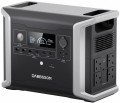Rated power
Power that a device can consistently produce for an indefinitely long time without any unpleasant consequences. For normal operation of the charging station, the rated power must be at least 15 - 20% higher than the total power of all devices simultaneously connected to it.
Peak power
Some electrical appliances (in particular, units with electric motors - refrigerators, air conditioners, etc.) consume significantly more energy at startup than after reaching the operating mode. For such a load, the peak power of the charging station must be taken into account - its indicator must be higher than the starting power of the load.
USB A (quick charge)
Full size
USB A ports with fast charging support. It allows you to charge your smartphone, tablet or other connected device much faster. The charging process takes place at increased power, and the current and voltage at each stage are regulated in such a way as to remain within the optimal values. However, it should be borne in mind that in our time there are many fast charging technologies and not all of them are compatible with each other.
- The strength of the current. The parameters of the current issued through the USB A fast charging connectors. Note that different voltage and current parameters can be output to different ports of the charging station. This item specifies the current values at a certain voltage (for example, 5 V / 3 A, 9 V / 2 A, 12 V / 1.5 A).
— Power. The maximum power in watts (W) that the charging station is capable of delivering through the USB A fast charging connector to one charging device. High output power allows you to speed up the charging process. However, the appropriate power must be supported by the device being charged - otherwise the speed of the process will be limited by the characteristics of the gadget.
USB C
USB type C ports are smaller than classic USBs, and they also have a convenient reversible design that allows you to connect the plug in either direction.
USB type C was originally designed to be able to implement various advanced features: increased power supply, fast charging technologies, etc.
Since the port is relatively new and quite powerful (there are
USB type C with a power of 60 W and even
100 W), the total number of such connectors is often limited to
1 port, less often
two).
- The strength of the power. The maximum power output through the USB type C connector to a charging device. Note that different ports of the charging station can output different power (for example, 1.5 A and 2.1 A). In this case, the highest power strength is usually indicated.
— Power. The maximum power in watts (W) that the charging station is capable of delivering to one rechargeable gadget. The high output power of the USB type C port allows you to speed up the charging process. However, the appropriate power must be supported by the device being charged - otherwise the speed of the process will be limited by the characteristics of the gadget.
Wireless charger
In wireless charging mode, energy is transferred to the gadget being charged through an inductive surface, which is usually built into the upper plane of the charging station case. There can be one slot for
wireless charging or several of them are provided. The range of this technology does not exceed a few centimeters. However, this method of charging eliminates the fuss with wires and reduces wear on the connectors. One of the key disadvantages of this format is considered to be low power and, accordingly, slow charging speed.
Add. ports
Additional output connectors provided in the design of the charging station in addition to those described above.
Connecting an additional battery
Ability
to connect an external battery to the charging station to increase the overall energy consumption and, as a result, extend the battery life. This connection is fast and convenient. On the other hand, the battery takes up extra space on the outside, making the whole structure more cumbersome.
Battery capacity
Nominal
battery capacity, in fact - the amount of energy that is supposed to be stored. The larger it is, the longer the battery life of the charging station will be, all other things being equal. On the other hand, this parameter also affects the dimensions, weight and price of the battery, despite the fact that an energy-intensive battery is not always required. By the indicator of capacity in watt-hours, you can compare batteries with each other.
Charging cycles
The number of charge-discharge cycles that the battery can withstand without significant loss of performance.
In the process of operation, the batteries wear out, which causes their performance to suffer (in the first place, the capacity decreases). Battery life is usually measured in charge-discharge cycles. However, models with the same declared resource are not always equally durable in practice. Different manufacturers may interpret “significant loss of performance” in different ways: for example, one brand indicates the resource up to a 20% decrease in capacity (DOD > 80%), another - up to a 60% decrease (DOD > 40%) Behind the abbreviation DOD worth decoding Depth of Discharge, i.e. discharge depth. Therefore, when choosing, it makes sense to focus not only on pure numbers, but also on other sources - test results, reviews, etc. Also note that battery life can be noticeably reduced if the operating conditions are violated (for example, in case of overheating or hypothermia).

